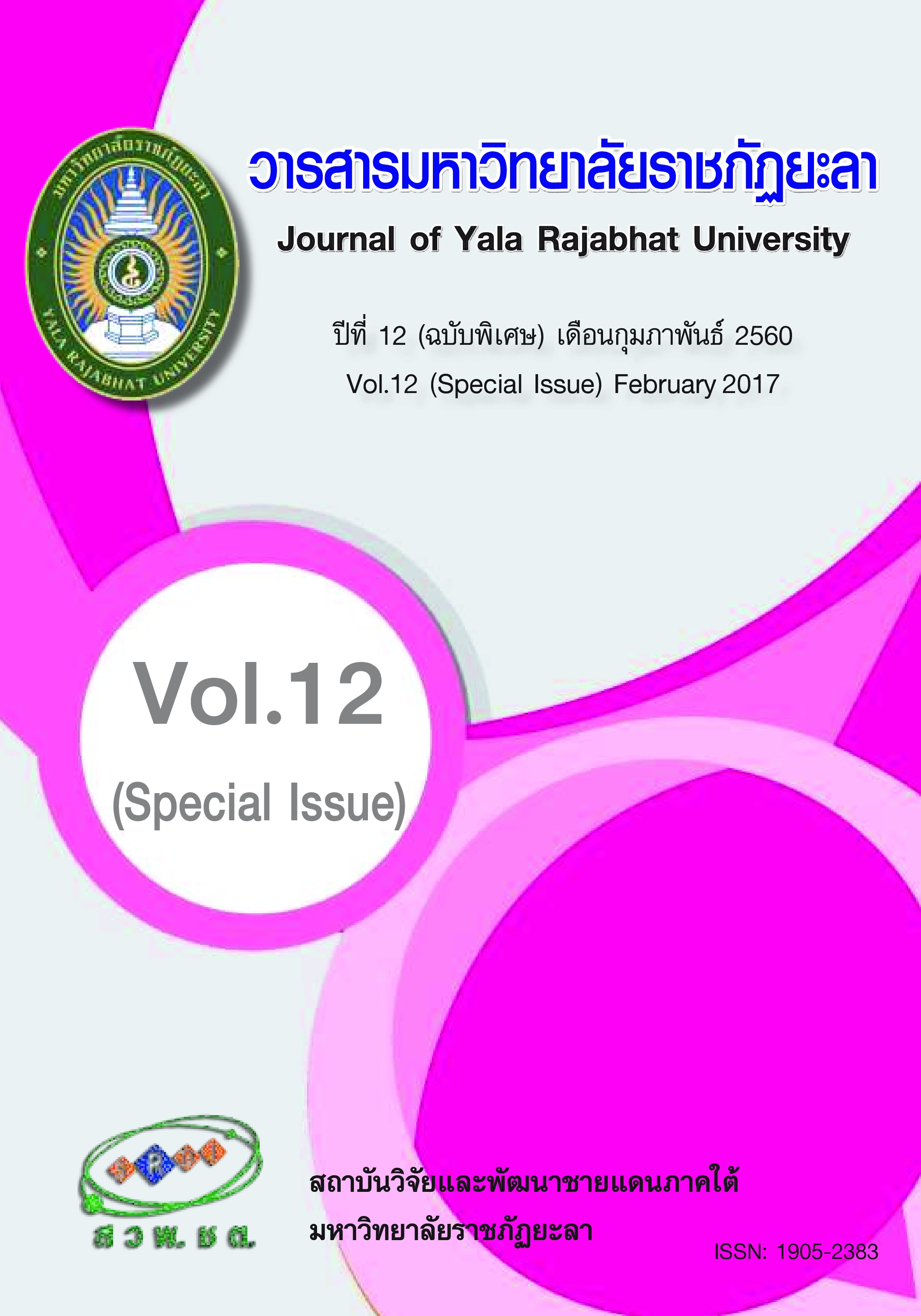ความได้เปรียบในการแข่งขันของผู้ประกอบการวิสาหกิจขนาดกลางและขนาดย่อมประเภทอุตสาหกรรมแปรรูปการเกษตรภาคเหนือตอนบนของประเทศไทย
Main Article Content
บทคัดย่อ
การวิจัยมีวัตถุประสงค์เพื่อศึกษาระดับความคิดเห็นของภาวะผู้ประกอบการ เครือข่ายธุรกิจ วัฒนธรรมองค์การและความได้เปรียบในการแข่งขัน และเพื่อศึกษาปัจจัยที่มีอิทธิพลต่อความได้เปรียบในการแข่งขันของวิสาหกิจขนาดกลางและขนาดย่อม ประเภทอุตสาหกรรมแปรรูปการเกษตร ภาคเหนือตอนบนของประเทศไทย ประชากร คือ ผู้ประกอบการ จำนวน 119 คน เครื่องมือวิจัย คือ แบบสอบถาม โดยใช้สถิติพรรณนาวิเคราะห์ค่าเฉลี่ย ค่าร้อยละ และส่วนเบ่ยงเบนมาตรฐาน และสถิติอนุมานวิเคราะห์สมการโครงสร้างด้วยเทคนิค SMARTPLS2.0 ผลวิจัยพบว่า ผู้ประกอบการมีความคิดเห็นต่อภาวะผู้ประกอบการ และวัฒนธรรมองค์การ อยู่ในระดับมากที่สุด ส่วนเครือข่ายธุรกิจ และความได้เปรียบในการแข่งขัน อยู๋ในระดับมาก การวิเคราะห์สมการโครงสร้างพบว่า ภาวะผู้ประกอบการมีอิทธิพลทางตรงต่อวัฒนธรรมองค์การ มากที่สุด รองลงมา คือ ภาวะผู้ประกอบการมีอิทธิพลทางตรงต่อเครือข่ายธุรกิจ วัฒนธรรมองค์การมีอิทธิพลทางตรงต่อความได้เปรียบในการแข่งขัน ภาวะผู้ประกอบการมีอิทธิพลทางตรงต่อความได้เปรียบในการแข่งขัน และเครือข่ายธุรกิจมีอิทธิพลทางตรงต่อความได้เปรียบในการแข่งขัน
Article Details
บทความ ข้อมูล เนื้อหา รูปภาพ ฯลฯ ที่ได้รับการเผยแพร่ในวารสารมหาวิทยาลัยราชภัฏยะลานี้ ถือเป็นลิขสิทธิ์ของวารสารมหาวิทยาลัยราชภัฏยะลา หากบุคคลหรือหน่วยงานใดต้องการนำทั้งหมดหรือส่วนหนึ่งส่วนใดไปเผยแพร่ต่อหรือกระทำการใดๆ จะต้องได้รับอนุญาตเป็นลายลักษณ์อักษรจากวารสารมหาวิทยาลัยราชภัฏยะลาก่อนเท่านั้น
เอกสารอ้างอิง
2.Amit, R. & Schoemaker, P. J. (1993). Managing assets and skills: A key to sustainable competitive advantage. Strategic Management Journal, 31(1), 91-106.
3.Barney, J. B. (1991). Firm resources and sustained competitive advantage. Journal of Management, 17(1), 99-120.
4.Cameron, K. S. & Attington, D. R. (1996). The conceptual foundations of organizational culture. In Higher education: Handbook of theory and research volume IV. New York: Agathon Press.
5.Chiarakul, T. (2014). The problems and the adaptation of OTOP to AEC. Executive Journal, 34(1), 177-191. (in Thai)
6.Chuang, S. (2004). A resource-based perspective on knowledge management capability and competitive advantage: An empirical investigation. Expert Systems with Applications, 27(3), 459–465.
7.Dierickx, I. & Cool, K. (1989). Asset stock accumulation and sustainability of competitive advantage. Management Science, 35(12), 1504–1513.
8.Farinda, A. G., Kamarulzaman, Y., Abdullah, A. & Ahmad, S. Z. (2009). Building business networking: A proposed framework for Malaysian SMEs. International Review of Business Research Papers, 5(2), 151-160.
9.Kaewjomnong, A. (2015). Problems of small enterprise operators with readiness in participation in the ASEAN economic community: Cased study of Phatthalung Province. Journal of Business Administration The Association of Private Higher Education Institutions of Thailand, 4(2), 77-88. (in Thai)
10.Likert, R. (1970). The Human Resources: Cases and Concept. New York: Hart Cout Brace B. World in Coperated .
11.Makchang, S. & Kongnual, P. (2006). The research and development of a community enterprise network management system for building sustainable capacity in the locality: “Pakklongbangplakod Phra Samut Chedi Samutprakan” A study of local products. DRU Journal, 1(2), 65-78. (in Thai)
12.Meutia. (2013). Improving competitive advantage and business performance through the development of business network, adaptability of business environment and innovation creativity: An empirical study of Batik Small and Medium Enterprises (SME) in Pekalongan, Central Java, Indonesia. Aceh International
Journal of Social Sciences, 2(1), 11 - 20.
13.Miller, D. (1983). The correlates of entrepreneurship in three types of firms. Management Science, 29(7), 770-792.
14.Porter, M. E. (1998). On Competition. Boston: Harvard Business School. Porter, M. E. (1980). Competitive Strategy: Techniques for Analyzing Industries and Competitors. New York: Free Press.
15.Porter, M. E. (1985). Competitive Strategy: Techniques for Analyzing Industries and Competitors. New York: The Free Press.
16.Ringle, C. M., Wende, S. & Will, A. (2005). SmartPLS 2.0 [Online]. Retrieved March 16, 2016, from: www.smartpls.de.
17.Shane, S. & Venkataraman, S. (2000). The promise of entrepreneurship as a field of research. The Academy of Management Review, 25(1), 217-226.
18.Srikrajang, J., Sirisugandha, T. & Chotivanich, P. (2016). Impact of internal strategic marketing, job satisfaction and organizational commitment toward employee performance of Thai Private Hospitals. Journal of Yala Rajabhat University, 11(1), 155-171. (in Thai)
19.Suttisong, S., Pornpontam, B., Jirakraisiri, P. & Boonratanamaitree, A. (2014). Relationship between small and micro community enterprise management and sufficiency economy principles on Thai Silk producer group, in the Northeastern of Thailand. Social Sciences Research and Academic Journal,
9(25), 95-106. (in Thai)
20.The Office of SMEs Promotion. (2014). Thailand’s SME White Paper in 2014. Bangkok: The Office of SMEs Promotion. (in Thai)
21.Wingworn, B. (2015). The mediating effect of innovation, family constitution, business networking on entrepreneurship and family business performance. Journal of the Association of Researchers, 20(1), 46-61. (in Thai)
22.Wingworn, B., Wingwon, B. & Piriyakul, M. (2013). Structural effect of business environment entrepreneurship and determinant toward the family business performance in Upper Northern Region of Thailand [Online]. Retrieved July 15, 2015, from: http://www.phd-lpru.com/images/column_1383789174/
Boonchanit-Proceedings%20of%202nd%20I%20CORE%202013.pdf.


